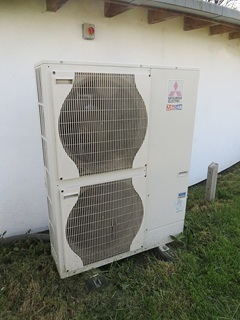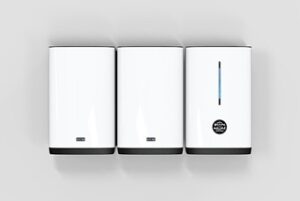We can store any excess of solar energy (or another form of green energy) in the walls and floors of our own homes. Or in a boiler. That might mean the end of the need for an expensive home battery. Moreover, this could prevent any congestion on the grid. Says heat pump producer Weheat. André Oerlemans wrote an article about it on change.inc.

In daytime, solar electricity tends to lose its value, because there is an ever growing supply of it. Moreover, the grid tends to become overcharged. We need a system that will store energy at daytime, and release it again at night. Dutch company Blauwe Batterij has developed a system establishing exactly this result. By using it, valueless solar electricity will become as valuable as natural gas again.
Smart software
The system comprises of a heat pump with smart software that determines everything. And a boiler system of 200 or 300 litres. The software will consider among others weather forecast, electricity prices, thermal capacity of the home and hours of occupancy. Factors that together determine the value of any electricity generated. If the electricity shadow price is low, the heat pump will generate extra energy and store it in the boiler or in the house. Sensors in floors and walls will indicate the choice made.
The benefit of this system is that it will be able to heat up as well as cool down the house. The thermostat will be set at such values that home temperature will increase or diminish by a maximum of 2 degrees. In the evening, walls and floors will gradually release the stored heat or cold. If the boiler is being heated, the heat pump will have to heat up water to a lesser extent for showering or cooking.

Prevention of grid congestion
Heat is of a much lesser value than an equivalent amount of electricity. But if the alternative is: buy electricity when it’s expensive, and sell it as it’s cheap, the equation will change. The principle of the boiler is: save gas and money by transforming electricity into warm water; and in so doing, prevent the delivery of solar power to the net.
We can store 18 up to 48 kilowatt-hours in walls and floors of a terraced house. In a boiler an additional 8 (200 litres) to 12 (300 litres) kilowatt-hours. This might make superfluous the home battery. We would more or less store any heat produced in our own home. Weheat company has successfully tested the system. The company also cooperates with housing associations; they will have to preserve part of their housing stock: by insulating 675,000 rental homes, and disconnecting 450,000 homes from natural gas.
In terraced houses, 18 to 48 kilowatt-hours of thermal energy can be stored in floors and walls. And in the boiler an additional 8 (200 litres) to 12 (300 litres) kilowatt-hours. This might make redundant the home battery. Any heat produced can be stored more or less in one’s own home. Weheat company tested the system in houses successfully.
Heat pump
The heat pump used by Weheat can heat up as well as cool down and store. The heat pump is being supplied with software that can regulate the system automatically. The system works so well that often, there is no need anymore for a central heating unit or home battery. Through their own heat pumps, people will be able to use more solar electricity of their own; beneficial if, as expected, netting (in which electricity supplied and delivered back are being subtracted from each other) will stop in 2027. For solar panel owners, this will make a difference. But in general, it will not be of major importance: delivering back will mainly occur when everyone attempts to do so. Use of electricity in the own home will mean that there will be less burden on the grid.
We can also store energy in the form of heat. According to supplier Tegelbeckers, such a system will have benefits over the home battery. For usually, the latter has a limited capacity of its own – enough to store solar electricity for just a few hours. A heat battery is simpler; it can store the energy for longer, and it is much cheaper. But they could also supplement each other.
Home battery
There is considerable uncertainty on the benefits of home batteries. One major reason is the unpredictability of the occupants. Home batteries aren’t cheap – at least 5,000 to 8,000 Euros. And payback time is hard to estimate. What is the makeup of the household? How will developments on the energy market influence the outcome? What will be the effect of any political choices to be made?
One can earn money with a home battery in two ways. One could use as much electricity from it as possible. Or one could return any electricity generated to the grid; even though this will earn less money, in the future. According to Dutch association Milieu Centraal, solar panel owners use a mere 30 per cent of the electricity generated, the remainder will be delivered to the grid. But if we use the electricity generated ourselves, we will remain in charge of our own energy use. And not be dependent anymore on electricity delivered by the grid. One could even set that on beforehand, on the basis of approximations.
Electricity trade
People could even trade any electricity they produce. Then one would have to charge the home battery as there is a lot of electricity available; and discharge it as there isn’t much of it, so that customers do not have to use expensive fossil electricity. For instance as they come home from work in the evening, start cooking and charging their electric vehicles. But if many would play into this imbalance, it would create a new imbalance again. Therefore, electricity companies brace themselves against such a scenario, by transmitting grid load with some delay.
Such a trade has nothing to do with sustainability, anyway. One makes use of imbalances in the new system, nothing more. The home battery is an essential part of the energy transition; but any trade using it will be temporary. ‘Any growth market will attract cowboys,’ says Koen Rozendom, CEO of energy company 1Komma5 Nederland. But in the end, they will not facilitate the transition.
Interesting? Then also read:
Battery storage
Bidirectional charging, solution for grid congestion
Local optimization of the grid
